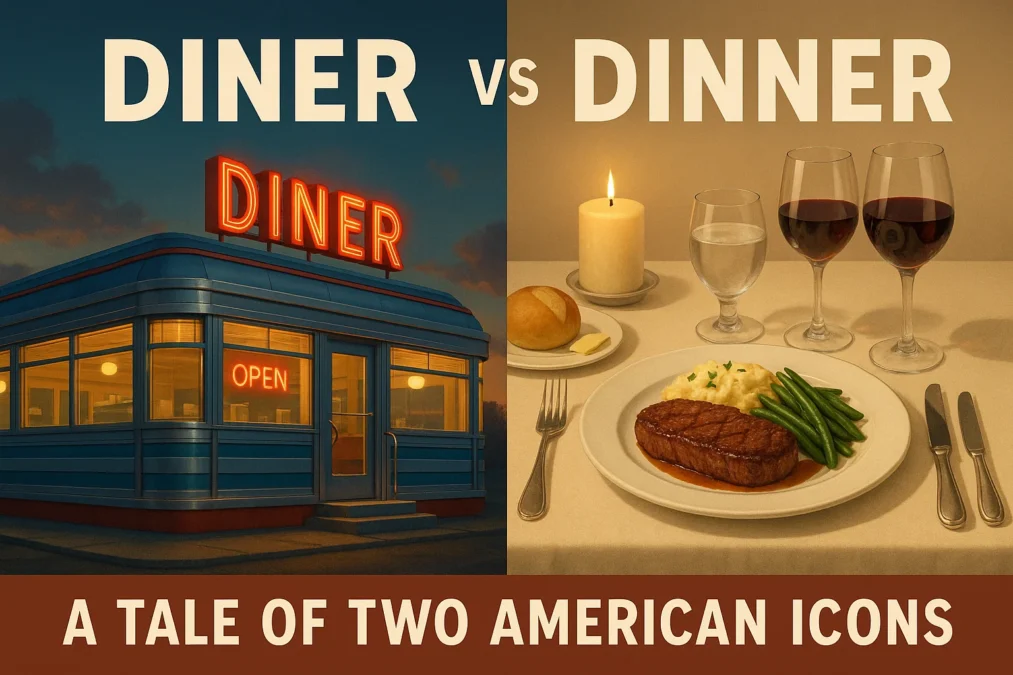It happens to the best of us. You’re typing a quick message or writing an email, and you pause. Is it “meet me at the diner” or “meet me at the dinner”? While your spellcheck might not always catch it, mixing up diner vs dinner is one of those homophone errors that can cause a moment of confusion. One word refers to the most important meal of the day, a time for family, connection, and nourishment. The other evokes the nostalgic image of a retro restaurant, with chrome siding, a long counter, steaming mugs of coffee, and comfort food served around the clock. Though they sound identical, their meanings are worlds apart.
Understanding the difference between diner vs dinner is more than just a grammar lesson; it’s a journey into the heart of American culture and language. One is a thing you eat, and the other is a place you eat it, but both are deeply woven into the social fabric of the United States. This comprehensive guide will do more than just define these terms. We will dive into the etymology of each word, explore their cultural significance, and provide you with clear, easy-to-remember tricks to never confuse them again. So, whether you’re a logophile, a history buff, or just someone who wants to avoid an awkward typo, let’s settle the diner vs dinner debate once and for all.
Unpacking the Meaning of Dinner
When people think of dinner, the concept seems straightforward. It’s the evening meal, right? Well, not always. The meaning of dinner is surprisingly fluid and can change based on geography, culture, and even social class. At its core, dinner refers to the main meal of the day. For many people in modern urban and suburban life, this meal is indeed consumed in the evening, after the workday is done. It’s a time for families to reunite, for friends to catch up over a restaurant table, or for a quiet moment of solitude at the end of a long day.
However, the history of the word tells a different story. The term dinner comes from the Old French word disner, which meant “to break one’s fast”—essentially, to have the first meal of the day. This linguistic root highlights how the meal we consider the most significant has shifted over centuries. In agrarian societies, the largest meal was often eaten around noon to refuel for the afternoon’s labor. This tradition persists in many parts of the world and in certain American regions, where the midday meal is called dinner and the evening meal is referred to as “supper.” So, when discussing diner vs dinner, it’s key to remember that dinner is primarily about the scale and importance of the meal, not just the time on the clock.
The Cultural Weight of the Dinner Table
Beyond its definition as a meal, dinner carries immense cultural and social weight. The phrase “family dinner” conjures a specific ideal: a shared table, home-cooked food, and meaningful conversation. Studies have often highlighted the benefits of regular family dinners, linking them to improved academic performance in children, better dietary habits, and stronger familial bonds. It’s a ritual of connection. Dinner is also the cornerstone of hospitality and celebration. We have dinner parties to entertain friends, holiday dinners like Thanksgiving that are central to national identity, and romantic dinners that mark anniversaries and special occasions.
The formality of a dinner can range wildly. It can be a quick microwave meal eaten on the couch, a lavish multi-course affair at a fine-dining establishment, or a hearty pot of stew shared with loved ones. This versatility is what makes the word so common and yet so personal. When we compare diner vs dinner, we are essentially comparing a specific, tangible type of restaurant against the vast, abstract concept of a meal that is fundamental to human social structure. Every diner serves dinner, but not every dinner is served in a diner.
Exploring the World of the Diner
Now, let’s turn our attention to the other half of the diner vs dinner equation. A diner is a specific type of restaurant, a distinctly American institution with a rich and colorful history. The classic image is unmistakable: a long, narrow building, often resembling a railroad dining car, clad in stainless steel or chrome. Inside, you’ll find a central counter with swiveling stool seats, a floor checkered with linoleum tiles, a bustling open kitchen, and large booths along the windows adorned with individual jukeboxes. The ambiance is unpretentious, the coffee is bottomless, and the menu is a novel of American comfort food classics.
The diner’s origin story is perfectly American itself, born from entrepreneurship and innovation. In the late 19th century, Walter Scott of Providence, Rhode Island, had the idea to sell food out of a horse-drawn wagon to night workers and newspapermen. These “night lunch wagons” were the precursors to the modern diner. As they grew in popularity, companies began manufacturing them prefabricated, often using retired trolley cars or, later, building them in the style of railroad cars to capitalize on the sleek, modern aesthetic of the rail travel era. This is why the diner architecture is so iconic and consistent.
The Diner as a Cultural Touchstone
The diner is more than just a place to eat; it’s a cultural stage. It has played a starring role in countless films, television shows, and works of literature, often depicted as a melting pot and a refuge for people from all walks of life. It’s where teenagers go after a football game, where cops on the night shift grab a donut, where late-night philosophers ponder life over a piece of pie, and where families stop for a reliable meal on a road trip. The diner is a democratic space—a place where everyone is welcome, and the menu prices reflect that.
The menu of a classic diner is a key part of its identity, and it directly fuels the diner vs dinner confusion because it’s where you go to eat dinner. It’s a sprawling document that offers something for everyone, 24 hours a day. From breakfast-all-day (pancakes, eggs, bacon) to hearty dinner plates (meatloaf, turkey with stuffing, pot roast) to sandwiches, burgers, and melts, the diner menu is a testament to American culinary comfort. It’s the home of the Greek-owned diner serving gyros alongside club sandwiches, of the waitress who calls everyone “honey,” and of the timeless appeal of a patty melt and a chocolate shake. The diner is an experience, a feeling of nostalgia and community.
Etymology and Grammar: Why Do They Sound the Same?
The confusion in the diner vs dinner dilemma is understandable because they are homophones—words that sound the same but have different meanings and spellings. Their similar sound is a coincidence of linguistic evolution. As mentioned, dinner stems from the Old French disner. Over time, the spelling and pronunciation simplified in Middle English to “dinner.” The word always pertained to the meal itself.
The word diner, on the other hand, is a classic example of an agent noun. In English, we often add the “-er” suffix to a verb to describe a person or thing that performs that action. A teacher teaches. A runner runs. Similarly, a diner is literally “one who dines.” It was first used in the early 19th century to describe a person eating a meal, particularly in a railroad dining car. By the 1890s, the term was seamlessly transferred from the person to the place itself—the railroad car or the restaurant-style wagon where the dining happened. So, the place was named after the action that occurs there.
A Simple Trick to Remember the Difference
If you struggle to keep diner vs dinner straight, there’s a very simple and effective mnemonic device you can use. Remember this phrase: “You eat dinner in the dining room.” Both “dinner” and “dining” contain an “N” and are related to the act of eating. Conversely, a diner is a place that ends with “-er,” just like other places such as a bakery or a brewery. It’s a building, an establishment. If you’re referring to the meal, it’s dinner with two “N”s. If you’re referring to the restaurant, it’s diner with one “N.” This simple trick can save you from a lifetime of spelling errors and clarify the diner vs dinner question instantly.
The Menu Showdown: Diner Food vs Dinner Food
Perhaps the most delicious way to explore the diner vs dinner distinction is through the food itself. What is typically served in each context? The term “dinner food” is incredibly broad. It can encompass virtually any cuisine, from a homemade lasagna to a sushi platter to a grilled steak with roasted vegetables. What defines dinner food is not the specific dish but its role as the primary, most substantial meal of the day. It’s often a balanced plate containing a protein, a starch, and vegetables.
Diner food, however, is a specific subcategory of American cuisine. It’s the food designed for efficiency, comfort, and mass appeal. It’s inherently nostalgic and rarely concerned with being trendy or health-conscious. A diner menu is a greatest hits album of American comfort food. Think of classics like fluffy buttermilk pancakes drenched in syrup, a patty melt on grilled rye, a towering club sandwich, meatloaf with gravy and mashed potatoes, or a simple, perfect grilled cheese with a side of tomato soup. It’s food that satisfies a deep craving for familiarity and warmth.
The Art of the All-Day Breakfast
A key feature that solidifies the diner vs dinner comparison is the diner’s legendary commitment to all-day breakfast. While most restaurants that serve dinner relegate eggs and pancakes to the morning hours, the diner democratizes breakfast. The ability to order a stack of pancakes or a Denver omelet at 10 PM is a quintessential diner privilege. This practice further blurs the lines between mealtime definitions, offering dinner-sized breakfast options at any hour. It reinforces the diner’s identity as a place of limitless choice and comfort, regardless of the time. For many, a late-night breakfast at a diner is their dinner, perfectly merging the two concepts in one sitting.
The Evolution of the Diner and the Changing Nature of Dinner
Both halves of the diner vs dinner pair have undergone significant evolution. The concept of dinner has been transformed by social and economic changes. The rise of dual-income households, demanding work schedules, and the proliferation of fast-casual and delivery services have changed how we approach our main meal. The formal, home-cooked family dinner every single night is, for many, an idealized memory. Dinner might now be a pre-prepared meal kit, a takeout order, or a solo act eaten in front of a screen. Yet, the cultural importance of the meal persists, even if its form is adapting.
The diner, too, has had to adapt to survive. The classic 1950s-style stainless steel diner is now a cherished relic, often protected by historical societies. Many have closed due to rising costs, competition from chain restaurants, and changing tastes. However, the spirit of the diner lives on. Its evolution has taken two main paths: first, the upscale “neo-diner” or “gourmet diner” that takes the classic comfort food concept and elevates it with higher-quality, often locally-sourced ingredients, while maintaining the casual atmosphere. Second, the aesthetic has been widely co-opted by chain restaurants like Denny’s or Waffle House, which carry on the tradition of 24-hour service and all-day breakfast, albeit in a less charismatic package.
Undergraduate vs Graduate: Understanding the Key Differences
The Enduring Appeal of Both
Despite these changes, the fundamental appeal of both remains strong. We still crave the connection and nourishment that a shared dinner provides, whether it’s around a family table or a video call with friends. Similarly, we yearn for the authenticity and comfort of a classic diner experience. In a world of fast-changing food fads, the diner represents stability and authenticity. The diner vs dinner question isn’t just about spelling; it’s about two enduring pillars of American life. One satisfies a biological need in a socially meaningful way, and the other provides the perfect, timeless setting for that need to be met.
Diner vs Dinner: A Side-by-Side Comparison
To crystallize the differences, here is a table summarizing the key distinctions in the diner vs dinner debate.
| Feature | Diner | Dinner |
|---|---|---|
| Part of Speech | Noun (a place) | Noun (a meal or event) |
| Definition | A casual, often retro-style restaurant serving comfort food. | The main meal of the day, often eaten in the evening. |
| Origin | From the verb “to dine” + “-er” (one who dines). | From Old French disner (to break one’s fast). |
| Key Identifier | Ends in “-er” (like other places: bakery, brewery). | Contains “din” (like dining room). |
| Experience | A place characterized by its ambiance: counters, booths, jukeboxes. | An experience centered around eating and socializing. |
| Menu | Fixed, focused on American comfort food and all-day breakfast. | Variable, can be any cuisine, from homemade to fine dining. |
| Time Association | Open 24/7 or for long hours, serving any meal at any time. | Traditionally a midday or evening meal, but defined by its importance. |
Famous Quotes and Cultural References
The concepts of diner and dinner are so ingrained in our culture that they frequently appear in famous quotes, songs, and movie lines.
On Diners:
- “A diner is a place where you can get a cup of coffee and a baked potato any time of the day or night.” — William H. Whyte, sociologist. This quote perfectly captures the limitless, utilitarian appeal of the diner.
- The iconic opening of the TV show Happy Days features the song lyrics “Hello everybody, well it’s time to meet the gang, at the diner on the corner, the place they call Arnold’s.” This cemented the diner as a central hangout and cultural hub for generations.
On Dinner:
- “After a good dinner, one can forgive anybody, even one’s own relations.” — Oscar Wilde. This witticism highlights the social and emotional power of a shared meal.
- “A family is a place where minds come in contact with one another. If these minds love one another, the home will be as beautiful as a flower garden. But if these minds get out of harmony with one another, it is like a storm that plays havoc with the garden.” — Buddha. While not directly mentioning dinner, this sentiment is often invoked to describe the importance of the family dinner table as the venue for this contact.
Conclusion
The journey through the diner vs dinner landscape reveals much more than a simple spelling difference. It uncovers a fascinating slice of linguistic history, social evolution, and American culture. Dinner, the meal, is a universal human experience, a daily ritual of sustenance and connection whose timing and content are wonderfully diverse. The diner, the place, is a uniquely American invention, a nostalgic, chrome-clad temple of comfort food that serves as a democratic gathering spot for all, at any hour of the day or night.
Remembering the difference is easy with the simple “dining room” mnemonic, but appreciating the depth of each term is a richer endeavor. One is the fuel for our bodies and souls, and the other is the classic venue where that fuel is served with a side of fries and a bottomless cup of coffee. So, the next time you make plans, you’ll know exactly what you’re suggesting: a home-cooked dinner or a night out at the local diner. Both are excellent choices, each satisfying a different kind of hunger.
Frequently Asked Questions (FAQ)
What is the main difference between diner and dinner?
The main difference is that dinner is a meal, specifically the main meal of the day, while a diner is a type of casual restaurant. The diner vs dinner confusion arises because they are homophones (sound the same). You eat dinner, and you go to a diner to eat it.
Can “diner” ever refer to a person?
Yes, but it’s less common in modern usage. Historically, “diner” meant “one who dines” (e.g., “The diners enjoyed their meal”). However, today, the primary meaning of diner is the restaurant itself. The word for a person is now more often “dinner guest” or simply “person having dinner.”
Why are some midday meals called dinner?
This is a key point in the diner vs dinner discussion. Dinner refers to the largest and most important meal of the day, not its specific timing. In historical agrarian societies and in some regions today, the largest meal was eaten at midday. This meal is called dinner, and the lighter evening meal is called “supper.”
Is every casual restaurant a diner?
No. The term diner specifically refers to a style of restaurant that originated from pre-fabricated lunch wagons and often features a distinctive architecture (like a railroad car), a long counter with stools, booths, and a menu heavy on American comfort food and all-day breakfast. A casual pizza place or taco shop would not typically be called a diner.
How can I easily remember how to spell diner and dinner?
Use this simple trick: You eat dinner in the dining room. Both words have two “n’s.” A diner is a place that ends with “-er,” just like other places (e.g., bakery, brewery). This mnemonic should permanently solve the diner vs dinner spelling dilemma.



